Simply French: Best Recipes of 2014 by Dorie Greenspan, David Lebovitz, Patricia Wells, Ann Mah, Mireille Guiliano, Alexander Lobrano, and Château Coutet
30 Tuesday Dec 2014
A Woman’s Paris™ in Book Reviews, Food
Tags
Alexander Lobrano, Ann Mah, Around My French Table Dorie Greenspan, Baking Chez Moi Dorie Greenspan, Bistro Cooking Patricia Wells, Bon Appetit, Château Coutet Aline Baly, Chez Panisse David Lebovitz, Chicken Liver Pâté with Caramelized Orange Segments Chateau Coutet, Cook's Illustrated, David Lebovitz, Dorie Greenspan, Double-Chocolate Marble Cake Dorie Greenspan, Edouard's Chocolate Chip Cookies Dorie Greenspan, Food & WIne, France, French baking, French bistros, French cafes, French cooking, French cuisine, French food, French restaurants, French Women Don't Get Facelifts Mireille Guiliano, French Women Don't Get Fat Mireille Guiliano, Gourmet magazine, Green Tea Sables Dorie Greenspan, Hungry for France Alexander Lobrano, Hungry for Paris Alexander Lobrano, Layered Raratouille Alexander Lobrano, Lobster Fricassee Chateau Coutet, Mascarpone Pears Poached in Sauternes Chateau Coutet, Mastering the Art of French Eating Ann Mah, Meet Paris Oyster Mireille Guiliano, Mireille Guiliano, My Paris Kitchen Cherry Tomato Crostini with Homemade Herbed Goat Cheese David Lebovitz, My Paris Kitchen David Lebovitz, New York Times, Oyster Vichyssoise Mireille Guiliano, Paris, Paris bakeries, Paris cafes, Patricia Wells, Salted butter caramel-chocolate mousse David Lebovitz, Saveur, Skirt Steak with Shallots Ann Mah, The Food Lover's Guide to Paris Astrance's Smoky Grilled Bread Soup Patricia Wells, The Food Lover's Guide to Paris Patricia Wells, The International Herald Tribune Patricia Wells, Travel + Leisure, Wall Street Journal, Willi's Wine Bar's Bittersweet Chocolate Terrine Patricia Wells
Share it
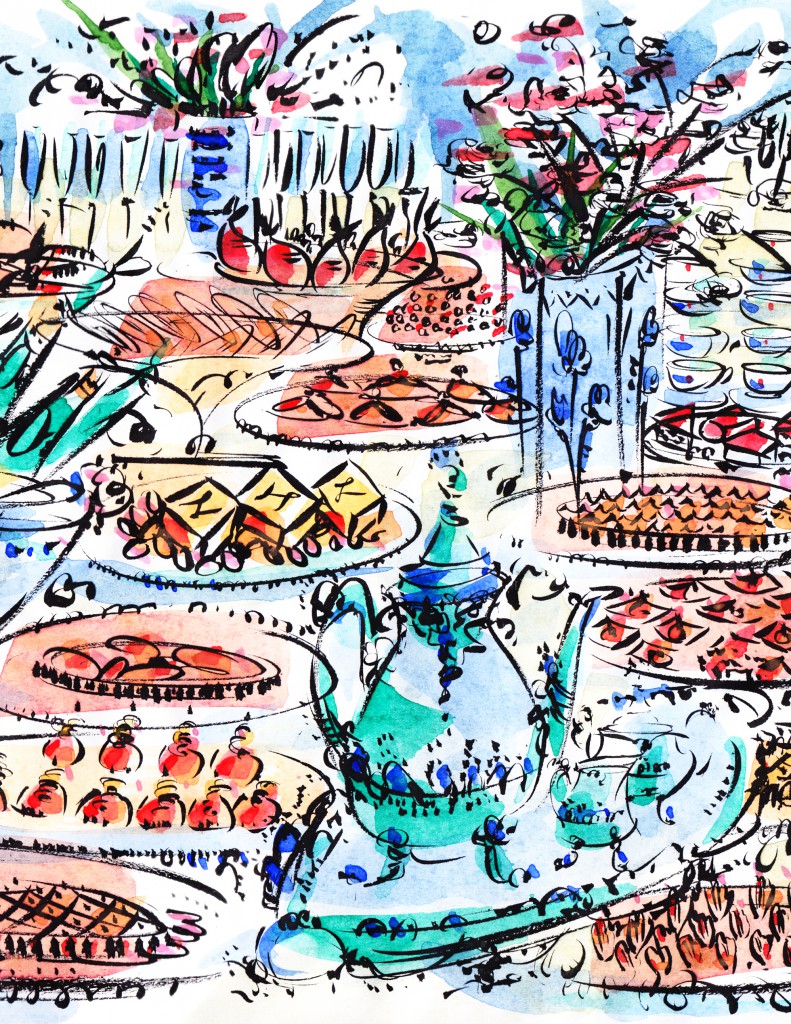 Sweet to Savory French! One does not need to be a chef or have great skills to cook the French recipes of Dorie Greenspan, David Lebovitz, Patricia Wells, Ann Mah, Mireille Guiliano, and Alexander Lobrano or the delicious sweet and savory dishes created by French chefs for Château Coutet.
Sweet to Savory French! One does not need to be a chef or have great skills to cook the French recipes of Dorie Greenspan, David Lebovitz, Patricia Wells, Ann Mah, Mireille Guiliano, and Alexander Lobrano or the delicious sweet and savory dishes created by French chefs for Château Coutet.
These extraordinary bakers, cooks, and chefs use few ingredients and the recipes are easy to put together, delicious to eat and fresh. It all has to do with the type of food you want to cook, how much time and money you want to spend.
Dorie Greenspan, a “culinary guru” and author of the award-winning Around My French Table: From My Home to Yours, returns with an exciting collection of simple desserts from French home cooks and chefs. In Baking Chez Moi: Recipes from My Paris Home to Your Home Anywhere, Dori explores the captivating world of French desserts, bringing together a charmingly uncomplicated mix of contemporary recipes that emphasis the French knack for elegant simplicity. Baking Chez Moi is an irresistible collection of radically simple desserts inspired by years of travel through France, incorporating the country’s traditions, specialties, and seasonal ingredients. Including recipes for Double-Chocolate Marble Cake, Edouard’s Chocolate Chip Cookies, and Green Tea Sablés, published with permission on A Woman’s Paris.
David Lebovitz has been a professional cook and baker for most of his life; he spent nearly thirteen years at Chez Panisse until he left the restaurant business to write books. He has been featured in Bon Appetit, Cook’s Illustrated, Travel + Leisure, Food & Wine, the New York Times, and more. In My Paris Kitchen: Recipes and Stories, David remasters the classics, introduces lesser-known fare, and presents 100 sweet and savory recipes that reflect the way modern Parisians eat today. Including recipe for Salted Butter Caramel-Chocolate Mousse and Cherry Tomato Crostini with Homemade Herbed Goat Cheese, published with permission on A Woman’s Paris.
Patricia Wells, for more than two decades the restaurant critic for The International Herald Tribune, is author of the award-winning Bistro Cooking, as well as a dozen other books. The Food Lover’s Guide to Paris: The Best Restaurants, Bistros, Cafés, Markets, Bakeries, and more is the enchanting and delicious revision of the classic bestseller with all new photos, 450 entries, 345 of which are entirely new. Patricia tells us what is new and wonderful, and what is gloriously familiar and still to be treasured. Including recipe for Willi’s Wine Bar’s Bittersweet Chocolate Terrine and Astrance’s Smoky Grilled Bread Soup, published with permission on A Woman’s Paris.
Ann Mah, food and travel writer and author of a food memoir Mastering the Art of French Eating: From Paris Bistros to Farmhouse Kitchens, Lessons in Food and Love, begins plotting gastronomic adventures à deux when her husband is given a diplomatic assignment in Paris. When her husband is called away to Iraq on a yearlong post—alone—turning Mah’s vision of a romantic sojourn in the City of Light upside down, she combats her loneliness by seeking out the epitome of French comfort food. Including recipe for Skirt Steak with Shallots, published with permission on A Woman’s Paris.
Mireille Guiliano, author of the New York Times bestseller French Women Don’t Get Fat, as well as French Women Don’t Get Facelifts, will have you eating oysters at least once every week—forget about saving them for special occasions only. From the table at Huîterie Régis in Paris to your own kitchen, her latest book Meet Paris Oyster: A Love Affair with the Perfect Food will transport you, and perhaps leave you craving oysters (or at least Paris)! Including recipe for Oyster Vichyssoise, published with permission on A Woman’s Paris.
Alexander Lobrano was the European Correspondent for Gourmet magazine from 1999 until it’s closing and has written about food and travel for Saveur, Bon Appetit, Food & Wine, the New York Times, Wall Street Journal, Travel + Leisure, and many other publications in the United States and the United Kingdom. Hungry for France: Adventures for the Cook & Food Lover is a culinary tour of some of the most alluring inns, food producers, restaurants and winemakers of France, with more than seventy-five recipes updating classic regional dishes. Including recipe for Layered Ratatouille Gratin, published with permission on A Woman’s Paris.
Aline Baly, third-generation owner of Château Coutet, tells us there are plenty of great traditional wine pairings with Château Coutet’s Sauternes and dry white wines, but that there are no rules. There is no need to be a Michelin star chef—a grilled lobster or a roasted turkey will do exceptionally well. And for pairing wines and cheese—Sauternes is the best hostess trick. Several sweet to savory recipes have been created for Château Coutet by French chefs Alex Yandell, Patrice Demangel, and Thomas Winslow. Including recipes for Chicken Liver Pâté with Caramelized Orange Segments, Lobster Fricassée, and Mascarpone Pears Poached in Sauternes, published with permission on A Woman’s Paris.
Bon appétit!
Dorie Greenspan’s “Baking Chez Moi” proves that there are no frontiers when it comes to goodness (excerpt)
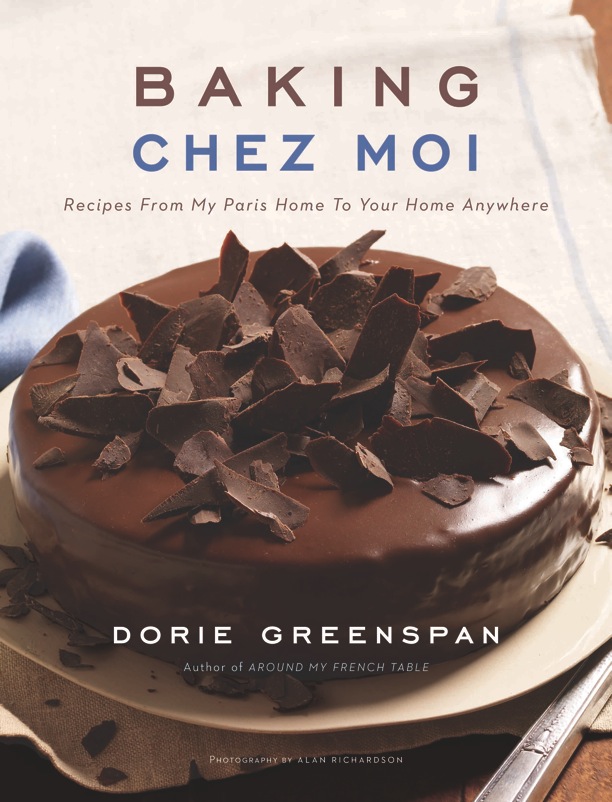 Excerpted from Baking Chez Moi, (c) 2014 by Dorie Greenspan. Used with permission of Houghton Mifflin Harcourt. All rights reserved. Including recipes for Double-Chocolate Marble Cake, Edouard’s Chocolate Chip Cookies, and Green Tea Sablés.
Excerpted from Baking Chez Moi, (c) 2014 by Dorie Greenspan. Used with permission of Houghton Mifflin Harcourt. All rights reserved. Including recipes for Double-Chocolate Marble Cake, Edouard’s Chocolate Chip Cookies, and Green Tea Sablés.
A “culinary guru” and author of the award-winning Around My French Table and Baking: From My Home to Yours, Dorie Greenspan returns with an exciting collection of simple desserts from French home cooks and chefs.
A little over five years ago, Dorie set out to observe and write about some of the best French pastry chefs behind the world’s most accomplished desserts—those towering architectural confections that are as much art as food. She went in search of what she called her “Ph.D. in Pastry.” However, it didn’t take her long to recognize that she was continually drawn to the simplest sweets—those of daily life—the home-baked cakes, tarts, pastries, and cookies we all crave every day. Baking Chez Moi is the culmination of all of Dorie’s discoveries, an irresistible collection of radically simple desserts inspired by years of travel through France, incorporating the country’s traditions, specialties, and seasonal ingredients as well as the recipes shared by talented home bakers and pastry chefs. To purchase Baking Chez Moi: Recipes from My Paris Home to Your Home Anywhere (Houghton Mifflin Harcourt), Visit: Baking Chez Moi.
Photo: © Alan Richardson
Desserts
Double-Chocolate Marble Cake
Baking Chez Moi by Dorie Greenspan, copyright © 2014. Published by Houghton Mifflin Harcourt.
Recipe: © Dorie Greenspan
Makes 8 servings
As all-American as marble cakes seem, that’s how all-French they seem as well. No matter where you go in France, no matter if the pastry shop is ritzy or rustic, you’re bound to find a marble cake. Aside from their obvious tastiness, marble cakes are beloved because they are hearty, long lasting and good from breakfast through late-night snacking. And when you bake them at home, they’re good for another reason: They’re fun to make. Running a knife through the dark and light batters, producing arcs, curves and swirls, can make anyone feel like Picasso. In fact, the temptation to keep swirling is so strong that the risk of ending up with a cake that goes from marbled to monochromatic is high. Resist!
I’ve given you a recipe for marbling a cake with white and dark chocolate. Because you’re adding chocolate to the entire cake, it’s a little more substantial than a traditional marble cake, which is part white cake and part chocolate cake. If you’d like to keep to tradition, see Bonne Idée.
Ingredients
– 2 cups (272 grams) all-purpose flour
– 1¼ teaspoons baking powder
– ¾ teaspoon fine sea salt
– 1½ sticks (12 tablespoons; 6 ounces; 170 grams) unsalted butter, at room temperature
– 1 cup (200 grams) sugar
– 4 large eggs, at room temperature
– 1½ teaspoons pure vanilla extract
– ½ cup (120 ml) whole milk, at room temperature
– 4 ounces (113 grams) best-quality white chocolate, melted and cooled
– ¼ teaspoon orange or peppermint oil (optional)
– 4 ounces (113 grams) semisweet or bittersweet chocolate, melted and cooled
Directions
1. Center a rack in the oven and preheat the oven to 325 degrees F. Pull out an insulated baking sheet or stack two regular baking sheets one on top of the other. Line the (top) baking sheet with parchment paper or a silicone baking mat. Butter a 9-×-5-inch loaf pan, dust with flour and tap out the excess; set it on the baking sheet(s).
2. Whisk the flour, baking powder and salt together in a small bowl.
3. Working in the bowl of a stand mixer fitted with the paddle attachment, or in a large bowl with a hand mixer, beat the butter on medium speed for 3 minutes, or until smooth. Add the sugar and beat for another 2 to 3 minutes, then add the eggs one at a time and beat for a minute after each one goes in. The batter may curdle, but you needn’t worry. Reduce the mixer speed to low and mix in the vanilla. Still on low speed, add the flour mixture in 3 additions and the milk in 2, beginning and ending with the dry ingredients and mixing only until each addition is incorporated.
4. Scrape half of the batter into another bowl. Using a flexible spatula, gently stir the white chocolate into half of the batter. If you’re using the orange or peppermint oil, stir it in as well. Stir the dark chocolate into the other half of the batter.
5. Using a spoon or scoop, drop dollops of the light and dark batters randomly into the prepared pan—don’t think too much about the pattern—and then plunge a table knife deep into the batter and zigzag it across the pan. It’s best to move forward and not to backtrack. Don’t overdo it—6 to 8 zigzags should suffice.
6. Bake the cake for 80 to 90 minutes, or until a tester inserted deep into the center comes out clean. Check the cake at the halfway mark, turn it around and, if it’s getting too brown, cover it loosely with a foil tent. Transfer the cake to a cooling rack and let it rest for 10 minutes, then unmold it, turn right side up on the rack and let come to room temperature.
Serving: Because of the cake’s lovely texture, you can cut it thin or thick and it will be good either way. It’s meant to be served plain, but every plain cake is good with ice cream and this one’s good with ice cream and chocolate sauce too.
Storing: Wrapped well, the cake will keep at room temperature for up to 4 days. It can be wrapped airtight and frozen for up to 2 months; defrost it in its wrapper.
Bonne Idée, Traditional Marble Cake: Omit the white chocolate. Stir the melted and cooled bittersweet chocolate into half of the batter and leave the other half plain. If you do this, you might want to add another ½ teaspoon vanilla extract to the plain batter.
Another Bonne Idée, Cardamom and Mocha Marble Cake: Make the batter and stir 1 teaspoon ground cardamom into the white-chocolate portion. Dissolve 2½ teaspoons instant coffee or espresso in 1 tablespoon boiling water and stir into the dark-chocolate portion.
Edouard’s Chocolate Chip Cookies
Baking Chez Moi by Dorie Greenspan, copyright © 2014. Published by Houghton Mifflin Harcourt.
Recipe: © Dorie Greenspan
Makes about 50 cookies
When Edouard Bobin, the co-owner of one of the sweetest small bistros in Paris, Le Pantruche, said he would give me the recipe for his favorite hazelnut cookie, I knew the minute I read the one-word title, Cookies, that chocolate chips would be involved. See the word “cookies” (or the words “les cookies”) in France, as you do nowadays in glossy magazines, modern bakeshops and trendy cafés, and it’s a pretty risk-free bet that the sweet will turn out to be a chipper. If there are nuts, they may be hazelnuts, pecans, walnuts or macadamias; there may even be a few M&M’s-type candies pressed into the dough; and the chocolate can be any kind, the basic cookie is always a play on the American chocolate chip.
And so it was with Edouard’s cookies. In fact, as I looked at the recipe, I thought it was the standard back-of-the-bag recipe. It had the American mix of baking powder and baking soda (the French mostly use packets with the two leavening agents already combined), the same amount of chocolate chips as you get in a U.S. bag and the same number of eggs as in the classic American recipe. I’d hoped for something new, and I didn’t think this was going to be it.
But I hadn’t noticed a couple of important differences: Edouard called for almost half again as much flour (by weight) as our classic recipe, and the nuts were ground not chopped, acting like even more flour. The cookies were chubby and chewy and just a little soft at the center—altogether great. If this is what the French think of as American cookies, we Americans can be proud.
Ingredients
– 3½ cups (476 grams) all-purpose flour
– 1¼ teaspoons fine sea salt
– ¾ teaspoon baking soda
– ½ teaspoon baking powder
– 2 sticks (8 ounces; 226 grams) unsalted butter, at room temperature
– 1 cup (200 grams) sugar
– 1 cup (200 grams) packed light brown sugar
– 1½ teaspoons pure vanilla extract
– 2 large eggs, at room temperature
– 12 ounces (340 grams) semisweet or bittersweet chocolate, coarsely chopped (or 2 cups chocolate chips)
– 1½ cups (150 grams) hazelnut or almond flour
Directions
1. Whisk the flour, salt, baking soda and baking powder together in a medium bowl.
2. Working in the bowl of a mixer fitted with the paddle attachment, or in a large bowl with a hand mixer, beat the butter on medium speed for about 1 minute, until smooth. Add both sugars and beat for another 2 minutes or so, until well blended. Beat in the vanilla. Add the eggs one at a time, beating for 1 minute after each egg goes in. Reduce the mixer speed to low and add the dry ingredients in 4 or 5 additions, mixing only until each addition is just incorporated. (Because you’re going to add more ingredients after the flour, it’s good not to be too thorough.) Still on low speed, mix in the chocolate and nut flour.
3. Divide the dough in half, wrap each piece airtight in plastic film and refrigerate for at least 2 hours. (The dough can be refrigerated for up to 3 days. Or, if it’s more convenient for you, you can scoop the dough now and freeze it in balls. You won’t need to defrost the cookies, but you will need to bake them a little longer.)
When you’re ready to bake: Center a rack in the oven and preheat the oven to 350 degrees F. Line two baking sheets with parchment paper or silicone baking mats.
Edouard says to scoop the dough into mounds the size of golf balls. A medium cookie scoop with a capacity of 1½ tablespoons is just right here, but you can also spoon the dough out using a rounded tablespoon of dough for each cookie. Place the dough on the lined sheets, about 2 inches apart.
Bake the cookies one sheet at a time for 8 minutes and then, using a metal spatula, gently press each mound down just a little; rotate the baking sheet. Bake for another 7 minutes or so, until the cookies are pale brown. They’ll still be slightly soft in the center, but that’s fine—they’ll firm as they cool. Pull the sheet from the oven and allow the cookies to rest for 1 minute, then, using a wide metal spatula, carefully transfer them to racks to cool to room temperature.
Repeat with the remainder of the dough, always using a cool baking sheet.
Serving: The cookies are good warm or at room temperature; good with coffee, good with tea and terrific with milk (a beverage I’ve never seen a grown French person sip); and even good with Armagnac.
Storing: The best way to maintain the cookies’ chewiness is to store them in a zipper-lock plastic bag; they’ll stay fresh for about 3 days. You can keep them longer, of course; just know that they’ll get a little firmer as time passes. Or pack them in an airtight container and freeze them for up to 2 months.
Green Tea Sablés
Baking Chez Moi by Dorie Greenspan, copyright © 2014. Houghton Mifflin Harcourt.
Recipe: © Dorie Greenspan
Makes about 40 cookies
I can’t remember how many years ago green-tea sweets became the rage in Paris. For the most part, the tea that was used was matcha (it’s still the pastry chefs’ favorite), a powdered tea that dissolves in water rather than steeps. Matcha is bitter, vegetal and divisive—a love-it-or-leave-it flavor—which is why I created these shortbread cookies using a mild tea. My preference is for berry- or citrus-flavored green tea, Earl Grey green tea (which gets its charm from bergamot, a type of lemon) or a spiced green tea. If you sniff the tea and like the fragrance, you’re bound to like the flavor.
Whether you make the cookie with loose-leaf tea or tea that you spill out of a tea bag, you’ll get the most flavor if you pulverize it and then work it into the sugar and salt with your fingertips.
Ingredients
– 1 stick (8 tablespoons; 4 ounces; 113 grams) unsalted butter
– 2½ teaspoons flavored green tea leaves
– ¼ cup (50 grams) sugar
– ¼ teaspoon fine sea salt
– 1¼ cups (170 grams) all-purpose flour
– Raw sugar, sanding sugar or granulated sugar, for rolling
Directions
1. Remove the butter from the refrigerator and leave it on the counter while prepare the other ingredients. You want the butter to be cool but pliable.
2. You can crush the tea with a mortar and pestle or you can put it between pieces of parchment or wax paper and crush with the bottom of a glass. Any way you do it, you want to end up with enough crushed tea to measure 1½ teaspoons.
3. Put the tea, sugar and salt in a large bowl and, using your fingertips, rub the ingredients together until you smell the aroma of the tea. Add the flour and stir everything together to mix well.
4. Cut the butter into 16 pieces. Drop them into the bowl, toss with your fingertips just to coat the pieces and then set to work rubbing the butter into the flour mixture to make a soft dough that will stick together when you press it between your fingers. Knead the dough gently to work it into a ball and then divide the ball in half.
5. Shape each piece of dough into a log about 7 inches long. Take care that the logs are solid—it’s easy to end up with hollows (you can feel them), which will turn into holes in the cookies. (See page 61 for a nifty way to get solid logs.) Wrap the logs and refrigerate them for at least 3 hours, or freeze for at least 1 hour.
When you’re ready to bake: Position the racks to divide the oven into thirds and preheat the oven to 350 degrees F. Line two baking sheets with parchment paper or silicone baking mats.
Sprinkle some raw, sanding or granulated sugar on the counter and roll the logs in it, just to coat the exterior. Trim the ends of the logs if they’re ragged, then slice into rounds that are 1/3 inch thick. Put the cookies on the baking sheets, at least 1 inch apart.
Bake for 12 to 14 minutes, rotating the baking sheets from top to bottom and front to back at the midway point, or until the cookies are golden brown on the edges and bottom but still pale on top. Let the cookies cool on the sheets for a few minutes, then transfer them to racks to cool to room temperature.
Serving: Just because they’re made with tea doesn’t mean these sablés aren’t good with coffee—they are. In fact, they’re especially good with espresso. And they’re nice with wine too.
Storing: The unbaked logs of dough will keep in the refrigerator for up to 3 days and can be frozen for up to 2 months; cut and bake directly from the freezer. Baked, the cookies will keep in a sealed container for about 4 days at room temperature.
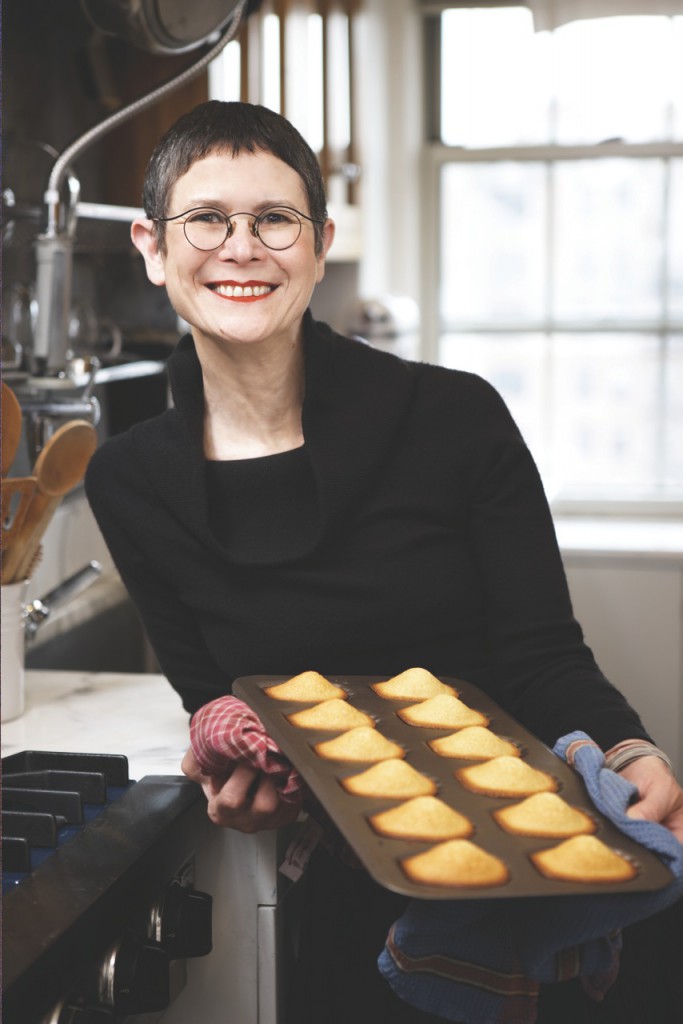 Dorie Greenspan, called a “culinary guru” by the New York Times and inducted into the Who’s Who of Food and Beverage in America, she is the author of ten cookbooks. Her most recent, Around My French Table, was on the New York Times bestseller list and named Cookbook of the Year for 2010 by the IACP, Epicurious, and Amazon. A three-time James Beard Foundation award winner for her cookbooks and magazine articles, Dorie has collaborated with many celebrated chefs, among them Julia Child (Dorie wrote the book Baking with Julia), Daniel Boulud, and Pierre Hermé, France’s most famous pastry chef. Her book Baking from My Home to Yours inspired the creation of Tuesdays with Dorie, a weekly online baking club that has been ongoing for over five years and was profiled in O, the Oprah Magazine. A similar group, French Fridays with Dorie, cooked its way through Around My French Table. Dorie’s own blog, which she started in 2007, was named one of the top twenty food blogs in the world by the Times of London.
Dorie Greenspan, called a “culinary guru” by the New York Times and inducted into the Who’s Who of Food and Beverage in America, she is the author of ten cookbooks. Her most recent, Around My French Table, was on the New York Times bestseller list and named Cookbook of the Year for 2010 by the IACP, Epicurious, and Amazon. A three-time James Beard Foundation award winner for her cookbooks and magazine articles, Dorie has collaborated with many celebrated chefs, among them Julia Child (Dorie wrote the book Baking with Julia), Daniel Boulud, and Pierre Hermé, France’s most famous pastry chef. Her book Baking from My Home to Yours inspired the creation of Tuesdays with Dorie, a weekly online baking club that has been ongoing for over five years and was profiled in O, the Oprah Magazine. A similar group, French Fridays with Dorie, cooked its way through Around My French Table. Dorie’s own blog, which she started in 2007, was named one of the top twenty food blogs in the world by the Times of London.
Dorie splits her time between New York, Connecticut, and Paris. For more information, visit: doriegreenspan.com.
Photo: © Alan Richardson
David Lebovitz’s “My Paris Kitchen” – quirks, trials, beauty, and joys of life in Paris (excerpt)
 Excerpted from My Paris Kitchen by David Lebovitz. Copyright © 2014 David Lebovitz. Used with permission of Ten Speed Press, an imprint of Random House LLC. All rights reserved. Including recipe for Salted butter caramel-chocolate mousse.
Excerpted from My Paris Kitchen by David Lebovitz. Copyright © 2014 David Lebovitz. Used with permission of Ten Speed Press, an imprint of Random House LLC. All rights reserved. Including recipe for Salted butter caramel-chocolate mousse.
In My Paris Kitchen, David remasters the classics, introduces lesser-known fare, and presents 100 sweet and savory recipes that reflect the way modern Parisians eat today. An intimate dinner party may start with little rounds of buttery Comté and ham wafers, black olive tapenade on herbed goat cheese toasts, and a platter of raw vegetables for dipping in beet hummus. When entertaining large groups, long-simmering dishes made in advance—lamb shank tagine, cassoulet, coq au vin—can be accompanied by butternut squash crumble, haricots verts with snail butter, and panisses soufflés. In Paris, no one ever says no to dessert, especially when offered a classic Madeleine, a slice of homey, simple honey-spice bread, or individual chocolate cakes with dulce de leche and fleur de sel. To purchase My Paris Kitchen, visit: (Amazon.com) (BarnesandNoble.com) (Powells.com) (IndieBound.org)
Appetizer
Cherry tomato crostini with homemade herbed goat cheese (Tartines de Tomates Cerises, Chèvre Frais Maison aux Herbes)
My Paris Kitchen by David Lebovitz, copyright © 2014. Published by Ten Speed Press, an imprint of Random House LLC.
Recipe: © David Lebovitz
Serves 4
I like to roast the tomatoes ahead of time—up to 8 hours in advance—so they have time to marinate in their own savory juices, which caramelize slightly, making a nice bit of sauce to drizzle over the top.
Herbed Fresh Goat Cheese
Ingredients
– 2 cups (480g) whole goats’ (or cows’) milk yogurt
– 1 generous tablespoon very finely minced mixed fresh herbs (be sure to include chives, as well as an assortment that could include thyme, sage, basil, or flat-leaf parsley)
– 1 tablespoon minced shallots
– 1 teaspoon minced garlic
– ¾ teaspoon sea salt or kosher salt
– Generous pinch of cayenne pepper
Roasted Cherry Tomatoes
Ingredients
– 1 1/2 pounds (680g) cherry tomatoes, stemmed and halved
– 3 tablespoons olive oil
– 2 cloves garlic, peeled and thinly sliced
– Handful of fresh herbs (any combination of rosemary or thyme sprigs, bay leaf, and basil or sage leaves)
– Sea salt or kosher salt and freshly ground black pepper
Toasts
Ingredients
– 4 thick slices bread, such as ciabatta, a country bread, or a sourdough that’s not too dense
– Olive oil
– 1 clove garlic, peeled
– A few leaves of fresh basil, sage, or flat-leaf parsley, for garnish
1. To make the herbed goat cheese, line a mesh strainer with a few layers of cheesecloth or muslin and set it over a bowl. Scrape the yogurt into the lined strainer, fold the cloth over the yogurt, and refrigerate the yogurt for 24 hours.
2. Put the strained yogurt into a bowl and mix in the herbs, shallots, garlic, salt, and cayenne pepper. Refrigerate until ready to use.
3. To roast the tomatoes, preheat the oven to 350ºF (180ºC). Combine the cherry tomatoes, olive oil, garlic, and herbs in a baking dish or pan that will hold them all in a snug single layer. Season with salt and pepper, mix well, and spread them out on the baking dish.
4. Roast the tomatoes for about 45 minutes, stirring once or perhaps twice during baking, until they’re wilted and their juices are starting to concentrate—and perhaps brown a bit—in the bottom of the baking dish. Scrape the tomatoes and any juices into a bowl and let cool to room temperature. They can sit up to 8 hours, and they improve the longer they sit.
5. When ready to serve, make the toasts. Preheat the oven to 350ºF (180ºC). Evenly brush the bread slices with olive oil. Place them on a baking sheet and toast for about 5 minutes, until light golden brown. Remove from the oven and when just cool enough to handle, rub the slices generously with the garlic clove. Let cool to room temperature.
6. To serve, thickly smear each piece of toast with the fresh herbed cheese. Pluck out the herbs and spoon the tomatoes and their juices over the toasts. Coarsely chop the herbs for the garnish, and scatter them over the top of each portion.
Dessert
Salted butter caramel-chocolate mousse (Mousse au chocolat au caramel au beurre salé)
My Paris Kitchen by David Lebovitz, copyright © 2014. Ten Speed Press, an imprint of Random House LLC.
Recipe: © David Lebovitz
Serves 6
There’s not much I can say about this. One bite will leave you just as speechless.
Ingredients
– 1/2 cup (100g) granulated sugar
– 3 tablespoons salted butter, cubed
– ¾ cup (180ml) heavy cream
– 6 ounces (170g) bittersweet or semisweet chocolate, chopped
– 4 large eggs, separated
– Rounded 1/4 teaspoon flaky sea salt, preferably flour de sel
1. Spread the sugar evenly over the bottom of a wide saucepan. Heat the sugar over medium heat. As it begins to liquefy at the edges, use a heatproof spatula to very gently drag the liquefied sugar toward the center. Watch carefully, as once the edges start to darken, the sugar is in danger of burning. Continue to cook, stirring very gently, until all the sugar is melted and begins to caramelize.
2. When the caramel is a deep amber color and starts to smoke, wait a moment for it to smell just slightly burnt, then remove it from the heat and quickly whisk in the butter, stirring until melted. Gradually whisk in the cream and stir until the little bits of caramel are completely melted. (A few can be stubborn, so be patient. You can strain the mixture if they simply refuse to budge.)
3. Once smooth, add the chocolate, stirring gently until it’s melted and smooth. Scrape the mixture into a large bowl and let it cool to room temperature. Once it’s no longer warm, whisk in the egg yolks.
4. In a separate bowl, whip the egg whites until stiff. Fold one-third of the whipped whites into the chocolate mixture, sprinkling in the flaky salt. Fold in the remaining beaten egg whites just until no streaks of white remain. Divide the mousse into serving glasses, or transfer it to a decorative serving bowl, and chill for at least 8 hours. While it might be tempting to serve this with whipped cream, I prefer to serve it pure, straight up with just a spoon.
 David Lebovitz has been a professional cook and baker for most of his life; he spent nearly thirteen years at Chez Panisse until he left the restaurant business to write books. He moved to Paris in 2004 and turned davidlebovitz.com into a phenomenally popular blog. He is author of six books, including The Perfect Scoop, Ready for Dessert, and a New York Times bestselling memoir called The Sweet Life in Paris. He has been featured in Bon Appétit, Cook’s Illustrated, Travel + Leisure, Food & Wine, the New York Times, and more. Follow David’s latest recommendations at: (Website) (Facebook) (Twitter)
David Lebovitz has been a professional cook and baker for most of his life; he spent nearly thirteen years at Chez Panisse until he left the restaurant business to write books. He moved to Paris in 2004 and turned davidlebovitz.com into a phenomenally popular blog. He is author of six books, including The Perfect Scoop, Ready for Dessert, and a New York Times bestselling memoir called The Sweet Life in Paris. He has been featured in Bon Appétit, Cook’s Illustrated, Travel + Leisure, Food & Wine, the New York Times, and more. Follow David’s latest recommendations at: (Website) (Facebook) (Twitter)
Photography by Ed Anderson
Interview: A Woman’s Paris interview with David Lebovitz
Patricia Wells’ “The Food Lover’s Guide to Paris” on Restaurants, Bistros, and Brasseries (excerpt)
Excerpted from The Food Lover’s Guide to Paris by Patricia Wells. Copyright © 2014 Patricia Wells. Used with permission of Workman Publishing Company. All rights reserved. Including recipe for Willi’s Wine Bar’s Bittersweet Chocolate Terrine.
The Food Lover’s Guide to Paris is the enchanting and delicious revision of the classic bestseller with all new photos, 450 entries, 345 of which are entirely new. In this beloved culinary guide, Patricia Wells takes readers, travelers and diners to the best restaurants, bistros, cafés, patisseries, charcuteries, and boulangeries that the City of Light has to offer. Each entry includes detailed practical information, from the closest metro stop, to the best way to make a reservation, and the not-to-miss specialties of each spot—each spot is personally selected and recommended by the foremost restaurant critic and acclaimed authority of French Cuisine.
The Food Lover’s Guide to Paris arms you with a handy collection of quick-reference indexes by category, such as: Open on Sundays, Vegetarian Friendly, Late Dining, Special Occasions, Good for Children, Garden or Terrace seating, Worthy Wine List, and more. In addition, the French/English food glossary will give you the tools to order perfectly every time. To purchase The Food Lover’s Guide to Paris (Workman Publishing), visit: FoodLoversParis.com
Photography: Workman Publishing/The Food Lover’s Guide to Paris
Dessert
Terrine au Chocolat de Willi’s Wine Bar (Willi’s Wine Bar’s Bittersweet Chocolate Terrine)
The Food Lover’s Guide to Paris by Patricia Wells, copyright ©2014. Workman Publishing Company.
Recipe: © Patricia Wells/Mark Williamson
Photo: © Workman Publishing/The Food Lover’s Guide to Paris
Serves 16
This irresistible chocolate dessert is one of my Paris favorites. Mark Williamson, owner of the popular Willi’s Wine Bar, generously shared this recipe, noting alongside, “Chef François has managed to achieve a good balance between solid, dense, unforgivably rich chocolate and an almost foie gras–like texture. On a good day.” He also added, “Depending upon one’s level of extreme gourmandise, this will make 15 to 18 portions.” While the original recipe calls for unsalted butter, I like to make it with salted butter, for it gives the terrine a bright, surprising edge. I also like a touch of vanilla in my chocolate desserts and so added a tiny dose. Note that the eggs in this recipe are not cooked.
Equipment
A double boiler; a heavyduty mixer fitted with a whisk; a 1-quart (1-l) rectangular bread pan, lined with foil
Ingredients
– 10 ounces (300 g) bittersweet chocolate, such as Valrhona Guanaja 70%
– 12 tablespoons (1½ sticks; 180 g) salted butter, at room temperature
– ½ teaspoon pure vanilla extract
– 4 large egg yolks, preferably organic and free-range
– 6 large egg whites, preferably organic and free-range
1. Break the chocolate into medium-size pieces. Cube the butter.
2. In the top of the double boiler set over, but not touching, simmering water, melt the chocolate, stirring from time to time. The process should take about 3 minutes. Remove the top of the double boiler from the heat and whisk in the butter, cube by cube, until it melts. Whisk in the vanilla extract. The mixture should be smooth, glossy, and shiny, not dull and oily. Let cool for 5 minutes. Whisk in the egg yolks, one by one. Transfer the mixture to a large bowl.
3. In the bowl of the mixer, whisk the egg whites at highest speed until stiff but not dry, about 1 minute.
4. Add about one third of the beaten egg whites to the chocolate mixture, thoroughly whisking until no streaks of white remain. This will lighten the chocolate mixture and make it easier to blend with the remaining egg whites. Add the remaining whites to the chocolate mixture, and with a spatula, gently fold them in until no streaks of white remain.
5. Pour the mixture into the prepared pan. Cover securely with aluminum foil and refrigerate for a minimum of 6 hours and up to 3 days. To serve, carefully remove the terrine from the pan and cut into slices.
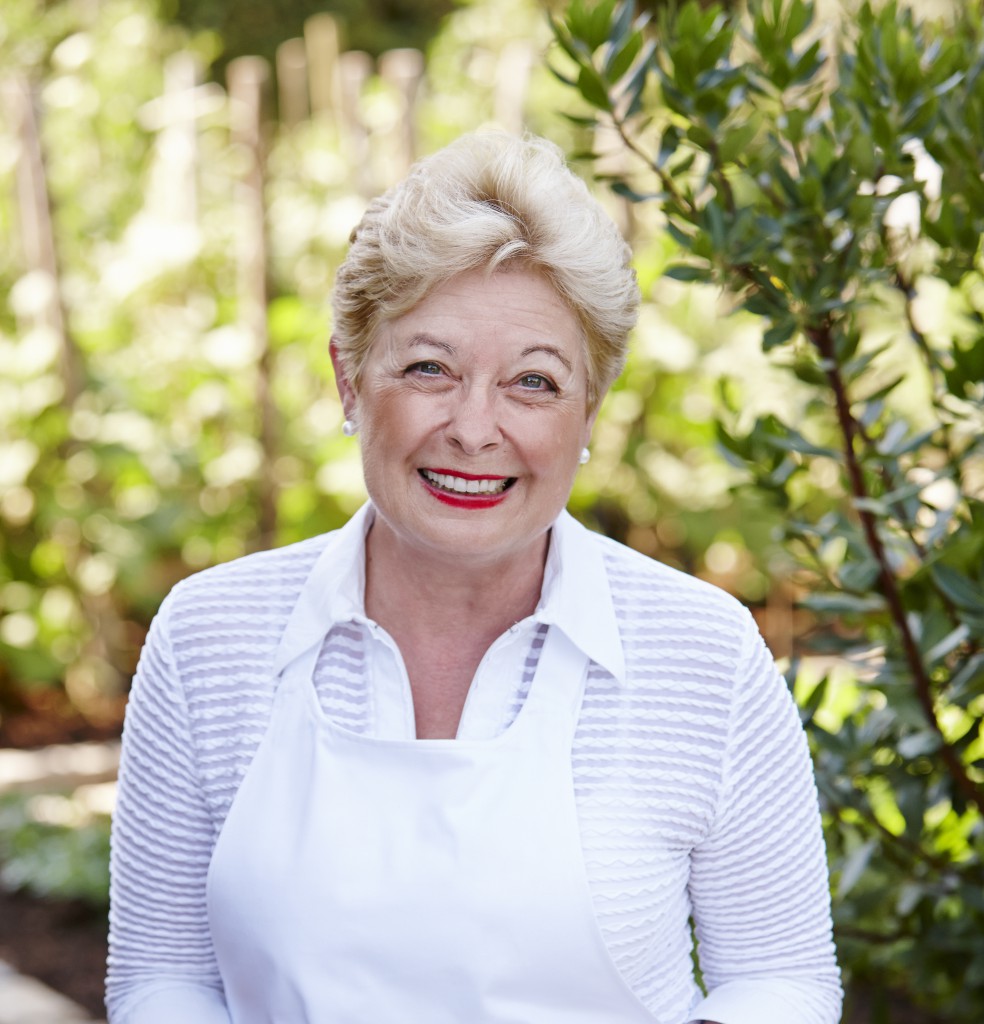 Patricia Wells, for more than two decades the restaurant critic for The International Herald Tribune, is the author of the award-winning Bistro Cooking, as well as more than a dozen other books. She also runs a successful cooking school—At Home with Patricia Wells—in Paris and Provence, where she and her husband have lived for more than 30 years.
Patricia Wells, for more than two decades the restaurant critic for The International Herald Tribune, is the author of the award-winning Bistro Cooking, as well as more than a dozen other books. She also runs a successful cooking school—At Home with Patricia Wells—in Paris and Provence, where she and her husband have lived for more than 30 years.
She won the James Beard Award for The Provence Cookbook, Patricia Wells at Home in Provence, and Simply French. Also nominated for Beard Awards were Vegetable Harvest and The Paris Cookbook. With her husband, Walter, she is also the author of We’ve Always Had Paris . . . and Provence. The French government has honored her as a Chevalier de l’Ordre des Arts et des Lettres, recognizing her contribution to French culture. A former New York Times reporter, she is the only foreigner and only woman to serve as restaurant critic for a major French publication, L’Express. For more information about Patricia Wells, visit: (Website) (Blog)
Photo portrait by Jeff Kauck
Interview: A Woman’s Paris interview with Patricia Wells
Ann Mah’s “Mastering the Art of French Eating” on the perfect steak frites the French way (excerpt)
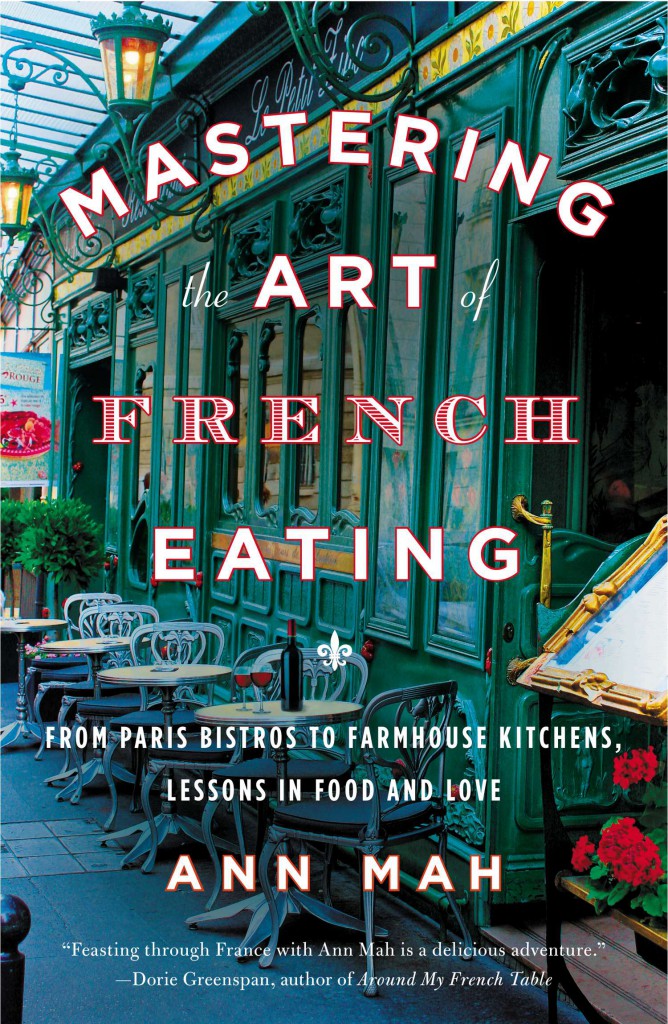 Excerpted from Mastering the Art of French Eating: From Paris Bistros to Farmhouse Kitchens, Lessons in Food and Love by Ann Mah. Copyright © 2014 by Ann Mah. Reprinted by arrangement with Penguin Books, a member of Penguin Random House. All rights reserved. Including a recipe for Bavette aux Échalotes (skirt steak with shallots).
Excerpted from Mastering the Art of French Eating: From Paris Bistros to Farmhouse Kitchens, Lessons in Food and Love by Ann Mah. Copyright © 2014 by Ann Mah. Reprinted by arrangement with Penguin Books, a member of Penguin Random House. All rights reserved. Including a recipe for Bavette aux Échalotes (skirt steak with shallots).
When journalist Ann Mah’s husband is given a diplomatic assignment in Paris, Mah, a livelong foodie and Francophile, begins plotting gastronomic adventures à deux. Then her husband is called away to Iraq on a yearlong post—alone—turning Mah’s vision of a romantic sojourn in the City of Light upside down.
So, not unlike another diplomatic wife, Julia Child, Mah must find a life for herself in a new city. Journeying through Paris and the surrounding regions of France, Mah combats her loneliness by seeking out the epitome of French comfort food—cassoulet—and learning how the andouillette sausage is really made. She discovers the true stories behind the country’s signature regional dishes, exploring the history and taste of everything from boeuf Bourguignon to the crispiest of buckwheat crêpes. And somewhere between Paris and the south of France, she uncovers a few of life’s truths.
Mastering the Art of French Eating: From Paris Bistros to Farmhouse Kitchens, Lessons in Food and Love is interwoven with the lively characters Mah meets—from chefs to farmers to restaurateurs—and the traditional recipes she samples. Reading it will send you straight to the kitchen, or Paris—or both. Funny, intelligent, and deeply pleasurable, this is a story about love—of food, family, and France. (Penguin Books) To purchase Mastering the Art of French Eating, visit: (Purchase)
Main Course
Skirt Steak with Shallots (Bavette aux Échalotes)
This is my interpretation of a set of loose instructions given to me by William Bernet. At his restaurant, Le Severo, most of the meat arrives at your table sauce-free. The bavette aux échalotes (skirt steak with shallots) is one of the few exceptions. Like many classic bistro dishes, this one relies on the quality of its ingredients. Bernet would encourage you to use aged meat.
Serves 2
For the steak
Ingredients
– 1 skirt steak, 9 to 10 ounces, patted dry
– Salt and pepper to taste
– 1 tablespoon mild-tasting oil such as sunflower or grape seed
For the sauce
Ingredients
– 2 tablespoons unsalted butter
– 4 large shallots, peeled and thinly sliced
– 1 ½ tablespoons red wine vinegar
– 1 sprig fresh thyme
– ½ cup chicken or beef stock or water
Directions
Preparing the steak
Trim the steak of excess fat and season with salt and pepper. Place the oil in a skillet over medium-high heat. Test the heat of the pan by touching a wooden spoon to the oil—if the oil is hot, it will lightly sizzle. Place the steak in the pan. Cook for 2 minutes, until the underside is well seared and browned. Turn the steak and cook the second side for 40 to 50 seconds, or until medium rare. (Skirt steak is a thin cut, and the meat cooks very quickly.) Transfer to a plate, cover loosely with a tent of foil, and keep warm while you make the sauce.
Making the sauce
In the same skillet, heat 1 tablespoon of the butter with the meat drippings. Add the shallots and sauté over medium heat until golden brown, about 7 minutes. Add the red wine vinegar, thyme, and stock (or water), and bring the liquid to a boil. Cover and cook until the shallots have softened and the liquid has almost disappeared. Swirl in the remaining tablespoon of butter and add any juices released from the meat. Taste the sauce and adjust the seasoning, adding a few drops of vinegar if needed.
Slice the steaks against the grain into thin strips. Serve with the shallots spooned on top, accompanied by mashed potatoes or steamed green beans.
 Ann Mah is a food and travel writer and author of a food memoir, Mastering the Art of French Eating (Viking Penguin) and a novel, Kitchen Chinese (HarperCollins). Her articles have appeared in the New York Times, Condé Nast Traveler, the International Herald Tribune, South China Morning Post, Fodor’s guides, and other publications. Born in Orange County, California, Ann began her career in book publishing after graduating from UCLA. In 2005, she was awarded a James Beard Foundation culinary scholarship to study in Bologna, Italy. She currently divides her time between Paris—where she has lived since 2008—and New York City. Visit: (Website) (Facebook) (Twitter)
Ann Mah is a food and travel writer and author of a food memoir, Mastering the Art of French Eating (Viking Penguin) and a novel, Kitchen Chinese (HarperCollins). Her articles have appeared in the New York Times, Condé Nast Traveler, the International Herald Tribune, South China Morning Post, Fodor’s guides, and other publications. Born in Orange County, California, Ann began her career in book publishing after graduating from UCLA. In 2005, she was awarded a James Beard Foundation culinary scholarship to study in Bologna, Italy. She currently divides her time between Paris—where she has lived since 2008—and New York City. Visit: (Website) (Facebook) (Twitter)
Interview: A Woman’s Paris interview with Ann Mah
Mireille Guiliano’s “Meet Paris Oyster” on the Parisians’ love for them (excerpt)
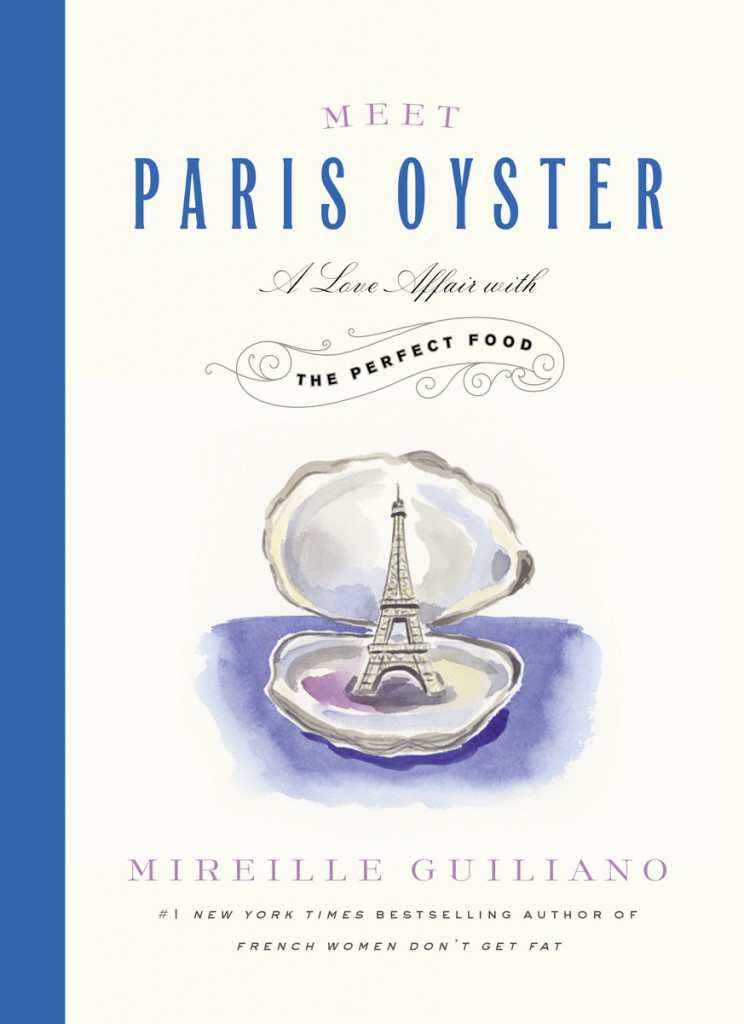
Excerpted from Meet Paris Oyster by Mireille Guiliano. Copyright © 2014 by Mireille Guiliano. Used with permission of Grand Central Publishing. All rights reserved. Including recipe for Oyster Vichyssoise.
With her characteristic wit, wisdom, and storytelling flair, Mireille will soon have you wanting to eat oysters at least every week—forget about saving them for special occasions only. She also shares her favorite oyster recipes and wine pairings. From the table at Huîtrerie Régis to your own kitchen, Meet Paris Oyster will transport you, certainly entertain you, and perhaps leave you craving oysters (or at least Paris)! Oh là là. To purchase Meet Paris Oyster (November 2014, Hachette Book Group), visit: Meet Paris Oyster.
Main Course
Oyster Vichyssoise
Meet Paris Oyster by Mireille Guiliano, copyright © 2014. Hachette Book Group.
Recipe: © Mireille Guiliano
Photo: © Alan Richardson
This will appeal to lovers of leeks, cream, and oysters. Count me in on that one, too. Served with a chilled muscadet, this dish makes for a perfect brunch course.
Serves 4
Ingredients
– ¾ cup crème fraiche, divided
– 2 tablespoons unsalted butter
– 3 medium Yukon Gold potatoes, peeled and cut into small cubes
– 4 leeks, white parts only, cleaned and minced
– 3–4 cups chicken stock
– ¼ cup dry white wine
– 1 tablespoon lemon juice
– Salt and freshly ground pepper
– 16 shucked oysters and their liquor, divided
Directions
1. Whip ¼ cup of the crème fraiche and reserve in the refrigerator.
2. Melt the butter in a saucepan over medium heat, add the potatoes and leeks, and sauté, stirring, for 3 minutes. Add 3 cups of chicken stock, the remaining ½ cup crème fraiche, the wine, and the lemon juice. Season to taste with salt and pepper, increase heat to medium high, and bring to a boil. Reduce heat to medium low and gently simmer until the potatoes are very tender, 25–30 minutes. Carefully transfer the mixture to a blender and puree or pass through a vegetable mill, adding more chicken stock if too thick. Place the pureed soup in a clean saucepan and add the oyster liquor; stir over medium heat until hot. Season to taste.
3. Place the raw oysters in warm soup dishes and pour the soup on top. The hot soup will “cook” the oysters slightly. Garnish with whipped crème fraiche and serve immediately.
 Mireille Guiliano, a former chief executive at LVMH (Veuve Clicquot), is “the high priestess of French lady wisdom” (USA Today) and “ambassador of France and its art of living” (Le Figaro). She is the author of the #1 New York Times bestseller French Women Don’t Get Fat: The Secret of Eating for Pleasure, as well as French Women Don’t Get Facelifts, and three other books. Born and raised in France, she is married to an American and lives most of the year in New York, Paris and Provence. Visit Mireille Guilano to learn more. (Website) (Facebook) (Twitter)
Mireille Guiliano, a former chief executive at LVMH (Veuve Clicquot), is “the high priestess of French lady wisdom” (USA Today) and “ambassador of France and its art of living” (Le Figaro). She is the author of the #1 New York Times bestseller French Women Don’t Get Fat: The Secret of Eating for Pleasure, as well as French Women Don’t Get Facelifts, and three other books. Born and raised in France, she is married to an American and lives most of the year in New York, Paris and Provence. Visit Mireille Guilano to learn more. (Website) (Facebook) (Twitter)
Portrait photo by Tim Knox
Interview: A Woman’s Paris interview with Mireille Guiliano
Alexander Lobrano’s “Hungry for France” – My appetite for France (excerpt)
Excerpted from 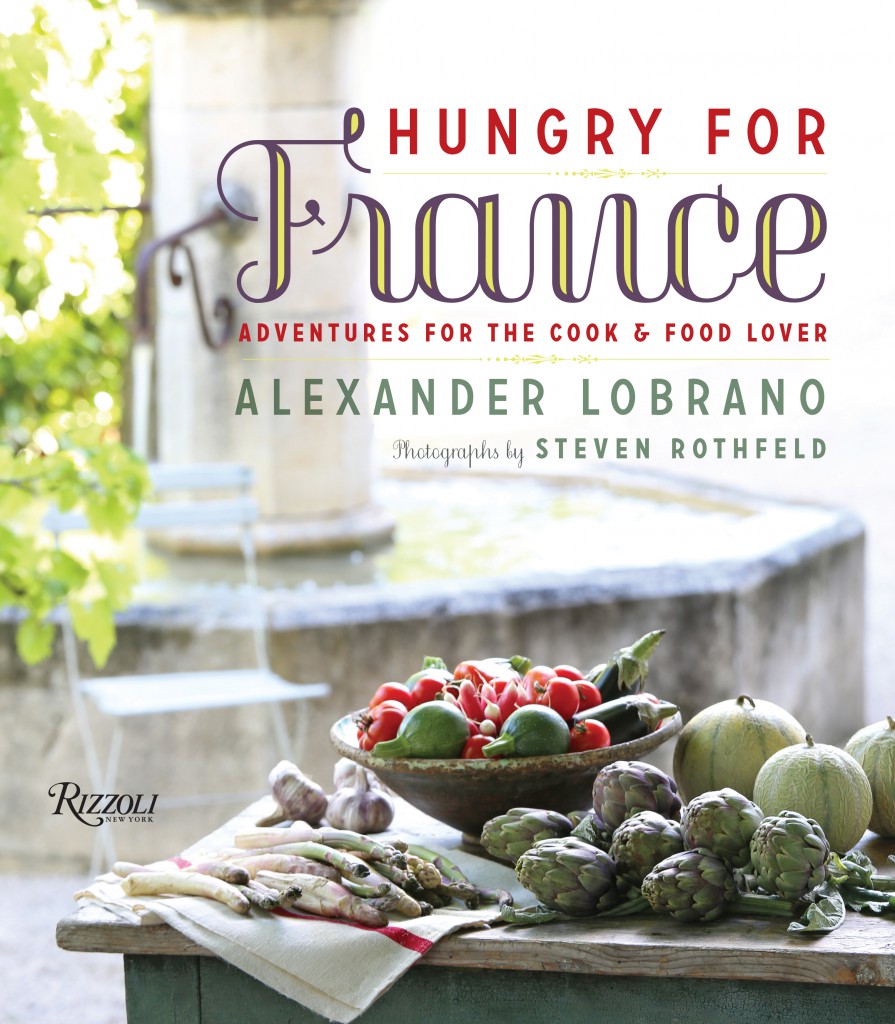 Hungry for France: Adventures for the Cook & Food Lover by Alexander Lobrano. Copyright © 2014 by Alexander Lobrano. Used with permission of Rizzoli New York. All rights reserved. Including recipe for Layered Ratatouille Gratin.
Hungry for France: Adventures for the Cook & Food Lover by Alexander Lobrano. Copyright © 2014 by Alexander Lobrano. Used with permission of Rizzoli New York. All rights reserved. Including recipe for Layered Ratatouille Gratin.
Every food lover’s ultimate dream is to tour the countryside of France, stopping off at luxurious inns with world-class restaurants and sampling fresh produce and regional specialties from local markets. Imagine having veteran food writer Alexander Lobrano as your guide—savvy bon vivant, someone who lives for the pleasures of the French table and knows just where to ferret out all the delicacies in each town. Lobrano shares thirty-plus years of exploring every corner of this gastronomically rich country with readers.
Beautifully photographed, the book’s thirteen chapters each cover a different region, from Normandy to Provence, and includes recommendations for a handful of the area’s most excellent, off-the-beaten-path restaurants, along with recipes. Hungry for France offers a delicious tour of some of the most alluring inns, food producers, and restaurants of France, with more than seventy-five recipes updating classic regional dishes. A complete list of addresses is provided to make trip planning easy. Hungry for France will inspire you to transform your cooking at home, as well as to help plan a culinary trip of a lifetime. To purchase Hungry for France: Adventures for the Cook & Food Lover (Rizzoli New York), visit: Hungry for France.
Main Course
Layered Ratatouille Gratin
Hungry for France by Alexander Lobrano. Rizzoli International Publications, Inc.
Recipe: © Jane Sigal
Chef Ronan Kervarrec of La Chèvre d’Or in the village of Eze alternates slices of zucchini and eggplant with homemade tomato sauce (in place of fresh tomatoes) beneath an herb-rich bread crumb topping. This late-summer tian is a remarkable make-ahead dish; the flavors just keep getting better. To make a vegetarian entrée, layer in sliced mozzarella cheese or dollops of fresh ricotta.
Tomato Sauce
Ingredients
– 1/4 cup (60 ml) extra-virgin olive oil
– 1/2 large onion, chopped
– 2 garlic cloves, sliced
– 1/2 pint (250 g) cherry tomatoes, halved
– 8 oz. (250 g) vine-ripened tomatoes, chopped
– 1 14.5-oz. (411-g) can diced tomatoes with juices
– 2 large basil sprigs with stems
– Kosher salt and freshly ground pepper
Gratin
Ingredients
– Extra-virgin olive oil, for brushing and drizzling
– 1 lb. (500 g) zucchini, sliced crosswise 1/4 inch (6 mm) thick
– 1 lb. (500 g) eggplant, quartered length wise and sliced crosswise 1/4 inch (1 cm) thick
– Kosher salt and freshly ground pepper
– 1 slice sourdough bread, about 1/2 inch (1 cm) thick, crust removed, toasted
– 2 garlic cloves, sliced
– 1/4 cup (8 g) packed mixed parsley, thyme, and rosemary leaves
Directions
1. Tomato sauce: In a large saucepan, heat oil until hot. Add onion and garlic and cook over medium heat, stirring occasionally, until softened, about 5 minutes. Add cherry tomatoes, vine-ripened tomatoes, diced tomatoes, and basil and season with salt and pepper. Bring to a simmer, then cook over medium heat until sauce thickens, 20 to 30 minutes. Discard basil. Using an immersion blender, puree sauce until smooth.
2. Gratin: Meanwhile, heat oven to 425°F (220°C). Brush 2 large rimed baking sheets with oil. Spread zucchini slices on one sheet and eggplant on other. Brush slices with oil and season with salt and pepper. Bake, rotating sheets halfway through, until tender, 15 to 20 minutes.
3. Tear bread into pieces. In a food processor, pulse bread into large crumbs. Add garlic and herbs and pulse until blended.
4. Brush a medium terrine or casserole with oil. Arrange half of eggplant slices in terrine, slightly overlapping. Spoon 1/2 cup (125 ml) tomato sauce on top. Layer half of zucchini slices on top, slightly overlapping, followed by another 1/2 cup (125 ml) tomato sauce; repeat layers. Sprinkle bread crumbs on top, season with salt and pepper, and drizzle with oil. Transfer to oven and bake, rotating terrine halfway through, until bubbling and crisp, about 20 minutes. Let stand for 5 minutes, then serve hot, warm, or at room temperature. Do ahead: Gratin can be refrigerated for up to 2 days.
8 side servings
 Alexander Lobrano grew up in Connecticut, and lived in Boston, New York and London before moving to Paris, his home today, in 1986. He was European Correspondent for Gourmet magazine from 1999 until it’s closing, and has written about food and travel for Saveur, Bon Appétit, Food & Wine, the New York Times, Wall Street Journal, Guardian, Travel & Leisure, Departures, Condé Nast Traveler, and many other publications in the United States and the United Kingdom. He is contributing editor at Saveur magazine and the author of Hungry for Paris. For more information, visit: www.alexanderlobrano.com.
Alexander Lobrano grew up in Connecticut, and lived in Boston, New York and London before moving to Paris, his home today, in 1986. He was European Correspondent for Gourmet magazine from 1999 until it’s closing, and has written about food and travel for Saveur, Bon Appétit, Food & Wine, the New York Times, Wall Street Journal, Guardian, Travel & Leisure, Departures, Condé Nast Traveler, and many other publications in the United States and the United Kingdom. He is contributing editor at Saveur magazine and the author of Hungry for Paris. For more information, visit: www.alexanderlobrano.com.
Interview: A Woman’s Paris Interview with Alexander Lobrano
Château Coutet: Exceptional food pairings with Château Coutet Sauternes and dry white wines (excerpt)
(Published with permission. © 2014 Château Coutet. All rights reserved.)
What are the great traditional wine pairings with Château Coutet’s Sauternes and dry white wines? The regions of Barsac and Sauternes have plenty of traditions, but there are no rules. Pairing a glass of Coutet with a savory dish is remarkable and enjoyed with lobster or turkey can be unforgettable. Both of these offer a pairing that highlights the beauty of contrast when it comes to texture. In terms of flavors, a turkey will allow you to explore the contrast of sweet and salty, while the lobster’s sweet meat compliments the wine. There is no need to be a Michelin star chef—a grilled lobster or a roasted turkey will do the job. Also, pairing wines with cheese—Sauternes is the best hostess trick. When offering guests a diverse cheese tray, Coutet’s wines are the safest to serve; they go with most cheeses. For a bit more perfection, toast your bread for a bit of texture.
Recipes: Appetizer, Main Course, and Dessert
Courtesy of Château Coutet, and chef’s Alex Yandell, Patrice Demangel, and Thomas Winslow. Photos courtesy Château Coutet
Appetizer
Chicken Liver Pâté with Caramelized Orange Segments
From the “Cook. Taste. Smile.” series by Alex Yandell
Ingredients for the pâté
– 6 tablespoons butter
– 2 shallots, finely chopped
– 2 rashers smoked streaky bacon, roughly chopped
– 2 cups chicken livers, trimmed
– 2 tablespoons brandy or amontillado sherry
– 2 tablespoons double cream
– ¼ teaspoon cayenne
– Sea salt and black pepper
Ingredients for the orange segments
– I large orange, peeled and cut into eighths
– ¼ tablespoons light brown sugar
– Toasted or crusty bread to serve
Preparation
1. Fry the shallots and bacon in 3 ½ tablespoons of the butter in a large frying pan over medium heat.
2. Once the shallots are soft and translucent, turn up the heat and add the chicken livers.
3. Fry until the livers are cooked and just slightly pink inside (2-3 minutes on each side).
4. Add the brandy to the pan and cook for 30 seconds.
5. Pour the mixture into a food processor and add the double cream.
6. Add the cayenne and blend well until smooth. Season to taste.
7. Pour the pâté into a ceramic dish or divide it between four ramekins.
8. Melt the remaining butter and pour it over the pâté.
9. Refrigerate for at least 3 hours before serving.
10. Meanwhile, dip the orange segments in the sugar to coat them.
11. Fry them in a dry non-stick pan over a medium-high heat until lightly caramelized.
12. Serve the pâté with toast and the caramelized orange segments alongside.
Main Course
Lobster Fricassée
Created for Château Coutet by Patrice Demangel, culinary consultant and trained at Alain Ducasse’s cooking school.
Serves 4
Ingredients
– 4 lobsters
– 7 ounces/2 deciliters Château Coutet wine
– 7 ounces/1 deciliters heavy cream
– 1 tablespoon chopped tarragon
– 2 ounces/5 centiliters hazelnut oil
Preparation
Immerse the live lobsters in boiling water for one minute. Remove the tails and cut into four slices. Split the head in half and carefully break open the claws. Sauté all the pieces over high heat in the hazelnut oil for five minutes. Deglaze the pan with Château Coutet, cover the pan and continue cooking for three minutes. Remove the lobster pieces. Add the cream to the pan and boil for three minutes. Strain the sauce and add the chopped tarragon.
Serve the lobster fricassée hot, accompanied with the sauce. Chef Demangel recommends serving with baby vegetables as a side dish.
Dessert
Mascarpone Pears Poached in Sauternes
Courtesy of Thomas Winslow, Chef
Ingredients for the pears
– 1 (750-ml) bottle of Sauternes
– ¼ cup agave nectar
– 1 whole vanilla bean, split and scraped
– 2 whole cloves
– ¼ teaspoon nutmeg
– Zest of 1 lemon
– Zest of 1 orange
– Juice of 1 orange
– Pinch of saffron
– 1-2 teaspoons honey
– 4 firm Bartlett, Anjou or Bosc pears, peeled leaving the stem intact and cored (ensure you core the pears from the bottom and keep the flesh intact—the goal is to make the pear look untouched while standing upright.
Ingredients for the mascarpone
– ½ cup mascarpone cheese
– ½ cup heavy cream
– Zest of ½ lemon
– Zest of ½ orange
– 1 teaspoon vanilla
Preparation of the pears
1. Place everything but the pears and zest in a 4-quart saucepan over medium heat and bring to a simmer. Cook slowly until the saffron begins to dissolve and the poaching liquid begins to take on a bright saffron orange color (about 20 minutes).
2. Decrease the heat to medium low and place the pears and zest into the liquid. Cook for 30 minutes or until the pears are tender but not falling apart. Maintain a gentle simmer. If the pears float, set a few spoons on them to ensure they are entirely submerged.
3. Remove the pears to a serving dish, standing them upright, and place in the refrigerator. Reserve one cup of the poaching liquid.
4. Pipe the mascarpone filling (see recipe below) into the bottom of the pears when they have cooled.
5. After straining the reserved poaching liquid, reduce over low heat to a syrup-like consistency (do not use high heat or you will scorch the sauce).
6. Fill a squeeze bottle (or jar) with the syrup and add an equal part Sauternes as well as a teaspoon or two of honey to taste.
7. Serve the filled pears with vanilla ice cream, a bit of the Sauternes sauce and a glass of Sauternes.
Note: If you desire to increase the number of pears cooked the liquid need not be increased proportionally—just make sure there is always plenty of liquid to cover the pear flesh.
The poaching liquid can be made up to 2 days ahead of time—this will also intensify the final flavor.
Preparation of the mascarpone filling
1. Beat all but the cream until thoroughly combined.
2. Beat the cream into medium peaks.
3. Fold the mascarpone and whipped cream together
4. Using a pastry bag (or a Ziploc with a cut corner) pipe the filling into the cooled pears.
 Aline Baly, third generation owner, is currently responsible for the strategic marketing of Château Coutet. Originally from Paris, she also lived in Boston (USA), Hong Kong (China) and Madrid (Spain). After 20 years of expatriate life, Aline is pleased to finally be ‘home,’ while enjoying many travels around the world sharing with Coutet enthusiasts the essence of its exceptional terroir, refinement and distinction of its wine, not to mention its balance and finesse. For more information about Château Coutet, visit: (Website) (Email:
Aline Baly, third generation owner, is currently responsible for the strategic marketing of Château Coutet. Originally from Paris, she also lived in Boston (USA), Hong Kong (China) and Madrid (Spain). After 20 years of expatriate life, Aline is pleased to finally be ‘home,’ while enjoying many travels around the world sharing with Coutet enthusiasts the essence of its exceptional terroir, refinement and distinction of its wine, not to mention its balance and finesse. For more information about Château Coutet, visit: (Website) (Email:
info@chateaucoutet.com)
Château Coutet– Premier Grand Cru Classé en 1855 – AOC Barsac
33720 Barsac, France
Tél: +33 (0)5 56 27 15 48
Interview: A Woman’s Paris interview with Aline Baly
Text copyright ©2014 A Woman’s Paris®. All rights reserved.
Illustration copyright ©2012 Barbara Redmond All rights reserved.
barbara@awomansparis.com


